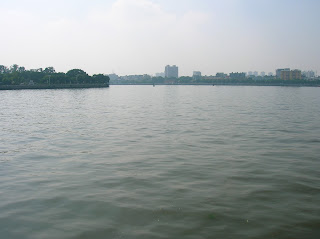After visiting Qingping and Huangsha Markets, we walked over to Shamian Island which is a sandbank island. It’s more quiet here than the city (as traffic is limited by the government) and has a touch of the European colonial period. There are historical buildings here as well as churches, hotels, restaurants, and souvenir stores. The island borders the Pearl River and is separated from the mainland by a canal. This island was an important port for Guangzhou’s foreign trade from the Song to Qing dynasty. Foreigners lived and did business here. The U.S. Consulate is here but they wouldn’t allow you to take photos of even the outside of the place. In the sixth pic below, the people are singing. I also took a photo of a married couple. It’s a nice area with trees and surprisingly clean air. We walked around for a few and then left to take the subway to go see a temple…







This is Duke. Greg, sure looks like European architecture. Do you know the history on who/when this happened?
ReplyDeleteRegarding Shamian Island, below is what I found off the web...
ReplyDeleteShamian Island was an important port for Guangzhou's foreign trade from the Song to the Qing Dynasty. From the 18th to the mid 19th century, the foreigners lived and did business in a row of houses known as the Thirteen Factories, near the present Shamian, which was then an anchorage for thousands of boat people. Shamian became a strategic point for city defense during the period of the First and Second Opium Wars. In 1859, the territory was divided in two concessions given to France and the United Kingdom (of which 3/5 belonged to the British and 2/5 to the French).
Trading companies from Britain, the United States, France, Holland, Italy, Germany, Portugal, and Japan built stone mansions along the waterfront. The construction on the island was characterized by climate-adapted but Western-plan detached houses with hipped roofs and large verandahs.
After 1949, the mansions of Shamian became government offices or apartment houses and the churches were turned into factories.
Very colonial archect. Charming. The canal reminded me of Venice, Italy -dont like canals. Nice gardens and very simple church. Pretty bride and nice photo of the happy couple-I am happy to see how you have detailed all the history of China as it pertains to what you are photographing. I bristle at the reference to the Opium Wars since it was very unfair of the British to blame this on the Chinese as the British soldiers were the opium eaters. Very modern yet cozy place that you photographed.
ReplyDelete